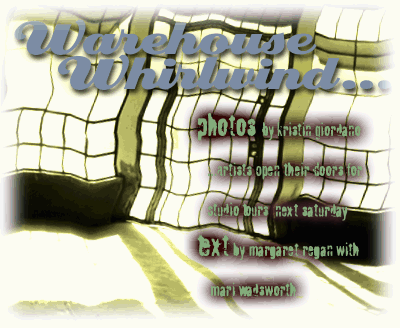
ONCE UPON A time, it was called Art Expo. It was a free
tour of the city's artists' studios, and the Tucson Pima Arts
Council was the sponsor.
 Then it happened that the funding was lost, and the artists rose
up and took charge of their own tour, marking the transition with
a new name: Xpo Chango. Buses delivered connoisseurs to studio
doors. Art lovers in search of paintings, sculptures, photographs
and sundry works of every media mix traipsed across creaking warehouse
floors. Reveling in the studios' adobe, red bricks and old wood,
they listened to the old-time rattle of the passing trains.
Then it happened that the funding was lost, and the artists rose
up and took charge of their own tour, marking the transition with
a new name: Xpo Chango. Buses delivered connoisseurs to studio
doors. Art lovers in search of paintings, sculptures, photographs
and sundry works of every media mix traipsed across creaking warehouse
floors. Reveling in the studios' adobe, red bricks and old wood,
they listened to the old-time rattle of the passing trains.
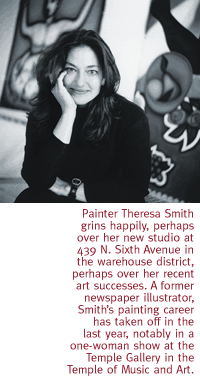 Then the artists grew weary, and the Tucson Arts District Partnership
stepped in. The event became the Tucson Arts District Studio Tour,
a commendably straightforward name that has stuck. The special
art buses, alas, are no more. Patrons must drive or walk, but
the tour still offers up the same stimulating melange of intelligently
rehabbed buildings left over from Tucson's industrial past and
an eclectic selection of Tucson arts.
Then the artists grew weary, and the Tucson Arts District Partnership
stepped in. The event became the Tucson Arts District Studio Tour,
a commendably straightforward name that has stuck. The special
art buses, alas, are no more. Patrons must drive or walk, but
the tour still offers up the same stimulating melange of intelligently
rehabbed buildings left over from Tucson's industrial past and
an eclectic selection of Tucson arts.
The first tour of the last year of the millennium is set for
Saturday, March 6.
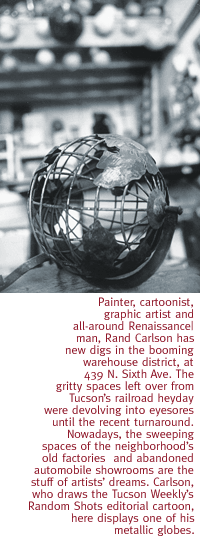 "This year there are 34 stops, including about 100 studios,"
says the Partnership's Herb Stratford. Visitors can meet the artists,
see works in progress and artists' demonstrations, and even buy
art, if the spirit so moves them. Studios are deliciously, notoriously
cluttered, but sometimes artists are moved to clean up the joint
for the occasion, transforming their messes into pristine (well,
sort of) galleries.
"This year there are 34 stops, including about 100 studios,"
says the Partnership's Herb Stratford. Visitors can meet the artists,
see works in progress and artists' demonstrations, and even buy
art, if the spirit so moves them. Studios are deliciously, notoriously
cluttered, but sometimes artists are moved to clean up the joint
for the occasion, transforming their messes into pristine (well,
sort of) galleries.
The tour, now offered twice a year, also provides a biannual
checkup on the health of the art scene. Boosters point to the
increasing number of artists opening their doors on the tour each
year. Artist-cum-landlord David Aguirre, who runs two studio buildings
along the tracks and works out of the venerable Steinfeld Warehouse,
is optimistic. While the movement for artists' equity has been
stalled, in part because of the continued Arizona Department of
Transportation ownership of dozens of downtown warehouse, Aguirre
doesn't believe artists will be priced out of downtown.
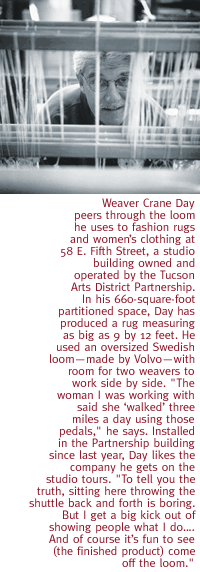 "We've all seen that happen in San Francisco, in Santa Fe,"
says Aguirre, who will show visitors his figurative ceramics.
"But we're blessed here to have decision makers who are sensitive
to that situation, who've said that's not going to happen here...(The
buildings) are not in the hands of landlords concerned with making
more and more money. That makes Tucson unique."
"We've all seen that happen in San Francisco, in Santa Fe,"
says Aguirre, who will show visitors his figurative ceramics.
"But we're blessed here to have decision makers who are sensitive
to that situation, who've said that's not going to happen here...(The
buildings) are not in the hands of landlords concerned with making
more and more money. That makes Tucson unique."
While many artists worried about rising rents don't share Aguirre's
rosy assessment, there's no question they've voted with their
feet in favor of downtown. The Partnership's Stratford estimates
that nowadays about 125 artists work downtown, and more keep coming.
Mary Ellen Wooten of the Partnership said her group took a survey
of Tucson artists and found about 175 seriously interested in
the downtown.
"There were a lot of people saying, 'Yes, I want to be in
a community of artists,' " Wooten notes.
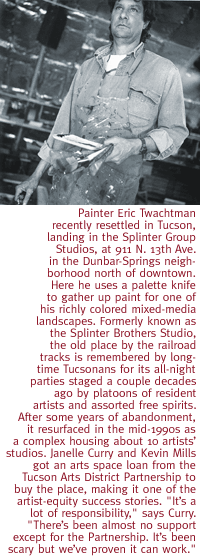 The downtown they're interested in is given an elastic definition
by the tour. (See the studio tour guide and map included in this
week's issue of the Tucson Weekly.) Its perimeters stretch
to the far northerly Splinter Group Studios at 13th Avenue and
Second Street in the Dunbar-Spring neighborhood and, at the other
end, farther south even than the Philabaum Contemporary Art Glass
Gallery, at 711 S. Sixth Ave. A block below Philabaum, roughly
considered the edge of the Arts District, are a couple of new
galleries called Red Swan (showing stone, glass and tile works)
and 840 Gallery (oils), incongruously standing at 842 S. Sixth
Ave.
The downtown they're interested in is given an elastic definition
by the tour. (See the studio tour guide and map included in this
week's issue of the Tucson Weekly.) Its perimeters stretch
to the far northerly Splinter Group Studios at 13th Avenue and
Second Street in the Dunbar-Spring neighborhood and, at the other
end, farther south even than the Philabaum Contemporary Art Glass
Gallery, at 711 S. Sixth Ave. A block below Philabaum, roughly
considered the edge of the Arts District, are a couple of new
galleries called Red Swan (showing stone, glass and tile works)
and 840 Gallery (oils), incongruously standing at 842 S. Sixth
Ave.
Iron Horse sets the eastern boundary, with a tour stop at Third
Avenue and Ninth Street, home of Apparatus Iron, the new Kore
Press studio and Sharon Holback's photography space. The unartistic
interstate sets the western border.
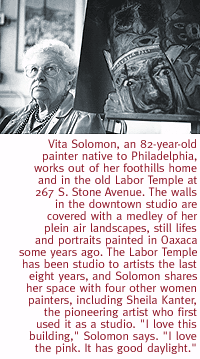 Clustered in the Warehouse District, between Toole Avenue and
Fifth Street just north of downtown, are dozens of new studios.
Among them are the Partnership's artists building on Fifth Street
and the gussied up George West at Sixth and Sixth. The International
Arts Center, located in the rehabbed YMCA in West University,
opens its doors to the public to show off its new live/work artists'
quarters, laboriously carved out of the old Y's dorm rooms and
rec rooms. (A leaking roof had badly damaged the interior.) Nine
artists will be receiving the public on tour day.
Clustered in the Warehouse District, between Toole Avenue and
Fifth Street just north of downtown, are dozens of new studios.
Among them are the Partnership's artists building on Fifth Street
and the gussied up George West at Sixth and Sixth. The International
Arts Center, located in the rehabbed YMCA in West University,
opens its doors to the public to show off its new live/work artists'
quarters, laboriously carved out of the old Y's dorm rooms and
rec rooms. (A leaking roof had badly damaged the interior.) Nine
artists will be receiving the public on tour day.
A thriving enclave in the true downtown gives hope to the city's
core, hard hit in the last year by the flight of merchants and
small galleries. Artist Daryl Childs will be showing pastels and
acrylics in his new gallery, D/C Harris, at 41 S. Sixth. Next
door at number 43 painter George E. Huffman will be presiding
in Raw Studio/Gallery, showing his own paintings along with work
by Joe Forkan and Michael Longstaff. Old standbys Studio 220 at
220 E. Congress and Susan Kay Johnson-Hannon at 113 E. Broadway
show that some artists refuse to give up on the downtown.
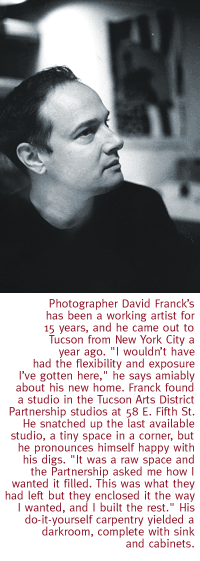 "It's really difficult downtown still," Huffman says,
"especially since a lot of people have left. But we nonetheless
are going to give it an even more serious go this year."
"It's really difficult downtown still," Huffman says,
"especially since a lot of people have left. But we nonetheless
are going to give it an even more serious go this year."
The Tucson Arts District Studio Tour runs from 10 a.m.
to 5 p.m., Saturday, March 6. Studio stops are listed in the guide
included in this week's issue of the Tucson Weekly. The
guide will also be available at all studio stops on tour day.
For more information call the Tucson Arts District Partnership
during regular business hours at 624-9977.

|





